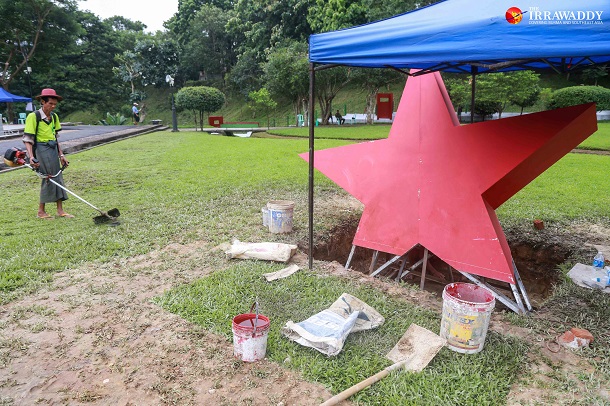RANGOON — Those who have previously visited the Martyrs’ Monument, sited just north of Rangoon’s Shwedagon Pagoda, should be prepared for a surprise on July 19, Martyrs Day—the anniversary of the assassination of independence hero Aung San and eight of his comrades in 1947.
The big white pointed star will be found missing from the upper left corner of the large red structure, which marks where Aung San and his eight comrades are interred. The exact spot where the star hung for the last three decades will have been hollowed out.
Those wondering where the star has gone need walk only a few meters beyond the mausoleum to find it half sunk into the ground.
“The fallen star symbolizes Gen Aung San and his colleagues. The hollow in the structure represents that they are gone and we have lost them,” said Sun Oo, one of the leading architects who designed the structure nearly thirty years ago.
Why these new design ideas after all these years?
The 61-year old architect said they are not new but were part of the original design proposed by his team.

“The construction team at the time ignored some points in our design under various pretexts,” Sun Oo recalled. More importantly, he was ordered by the government of the time, led by the military-socialist dictator Ne Win, not to highlight Aung San or his comrades in his design.
“We were not allowed to reflect the identities of those interred there,” he said.
As a result, Sun Oo has never felt pride over his work. “The mausoleum lacks the spirit it should have conveyed,” he said.
For these reasons, he had never visited the site until last month, when he was invited by the National League for Democracy-led government to oversee the revamp in the design of the mausoleum, in preparation for this year’s Martyrs Day, on July 19, when the government will stage its annual commemoration ceremony at the mausoleum.
Aside from the repositioning of the star, red granite slabs to be used as name plaques for those interred have recently arrived from China. The flagstaff is being repositioned from the top-middle to the right of the mausoleum, in accordance with the original design. Another architect from the original design team is working on billboards that will bear photos and bios of the independence heroes.
“They will be planted alongside the lane leading to the mausoleum. Some of Gen Aung San’s famous quotes will be printed on them,” said the architect Maw Lin, before explaining that the billboards were only temporary.

“In our original design, we included space for such things. This year, we are running out of time. That’s why we can only arrange temporary displays,” he added.
Sun Oo said the renovated mausoleum matches 95 percent of the original design. It still lacks features such as a museum about the leaders, which will “happen later.”
This is the first renovation of the mausoleum since its completion in 1985. After the 1988 military coup, the junta declared the site off-limits to the public, for fear of public gatherings contributing to unrest. The reformist military-backed administration of President Thein Sein, inaugurated in 2011, allowed public participation in the annual ceremony at the mausoleum.
President Htin Kyaw, consistent with his predecessor Thein Sein, will not be attending this year’s ceremony at the mausoleum. State Counselor Aung San Suu Kyi will be attending, as she has done in previous years.

















